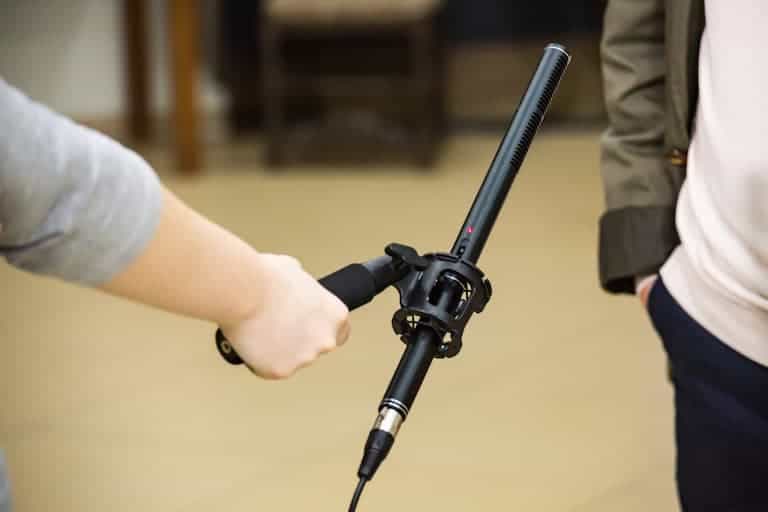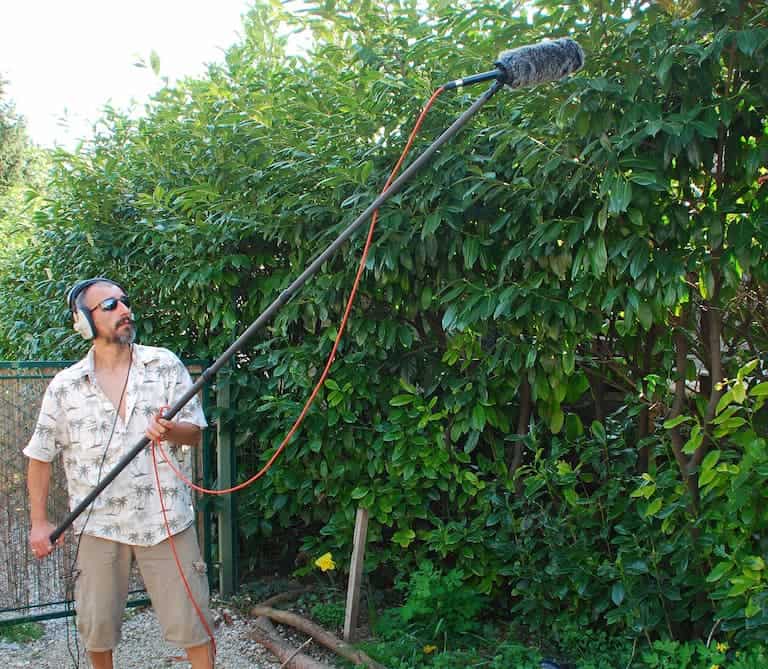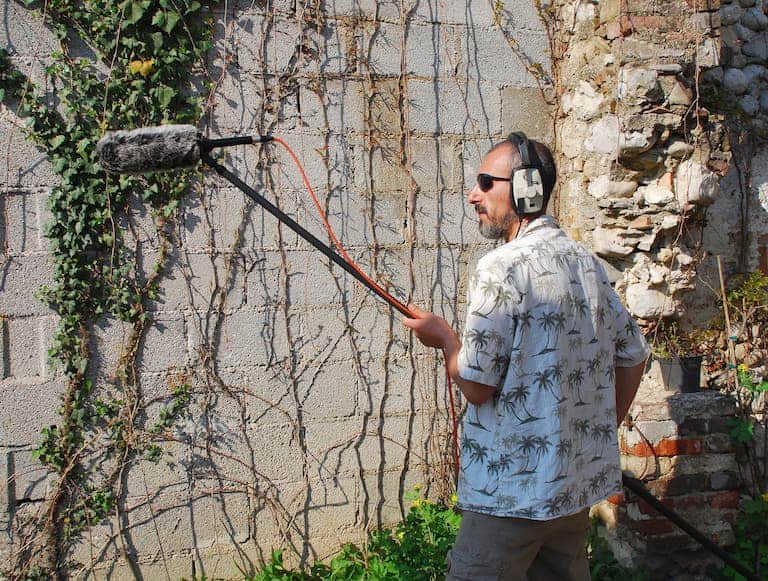The shotgun mic is often touted as a top contender for the perfect mic for voice-overs. However, some audio experts argue that these microphones are not a one-size-fits-all solution. All things considered, are shotgun mics the right pick for voice-overs?
Shotgun mics are great for voice-overs. They provide excellent clarity and make it easy to get a nice, clean recording. However, they must point directly at the sound source to avoid picking up too much background noise.
Read on for more insights into the pros and cons of using shotgun mics for voice-overs. By the end, you’ll be able to decide whether these mics are the right fit for your needs.

What Are the Benefits of Using Shotgun Mics for Voice-Overs?
Shotgun mics are best known for their directional properties. This means that they can pick up sound from a specific direction while significantly attenuating (or reducing) sound from other directions. But how do you benefit from this feature?
Here are the main benefits of using shotgun mics for voice-overs:
- They have a wide frequency response.
- They minimize background distractions.
- They eliminate echo and reverberations.
- They produce better sound quality.
- They are better for outdoor recording.
They Have a Wide Frequency Response
One of the main advantages of shotgun mics is their wide frequency response. This means they can capture a wide range of frequencies, from the low end to the high end. This is crucial for voice-overs because it allows you to capture all the nuances and subtleties of your voice.
For example, if you’re recording a soft, emotional scene, you’ll want to be able to capture the low, rumbling tones of your voice. On the other hand, if you’re recording an action-packed scene, you’ll want to be able to capture the high-pitched screams and yells. A shotgun mic with a wide frequency response will allow you to do both.

They Minimize Background Noise
Another benefit of shotgun mics is that they can help to minimize background noise. They are very directional, which means that if you’re recording in a noisy environment, a shotgun mic will pick up less ambient noise and more of your voice.
For example, if you’re recording a voice-over in a coffee shop, a shotgun mic will pick up less of the background chatter and more of your voice. It will only only picking up sound from the direction it’s pointing at—towards you.
In case you’re curious, this video describes how a shotgun mic works:
They Eliminate Echo and Reverberations
Shotgun mics can also help to eliminate echo and reverberations. This is because they are highly sensitive to sound from the direction they’re pointing in and less sensitive to sound from other directions.
For example, if you’re recording a voice-over in a room with hard surfaces (like concrete walls), a shotgun mic will pick up less of the echo and more of your voice.
They Produce Better Sound Quality
Shotgun mics are also known for producing better sound quality. They can focus on the sound you want to record and filter out any background noise. This makes them ideal for recording voice-overs, as you want the focus to be on your voice and not on any background noise.
They Are Better for Outdoor Recording
Shotgun mics are great for outdoor recording. As I mentioned, these mics pick up sound from a specific direction while reducing sound from other directions.
If you’re recording a voice-over outdoors, a shotgun mic will pick up less ambient noise and more of your voice. There can be a lot of background noise outdoors, so a directional microphone is key for getting a good recording.

What Are the Drawbacks of Using Shotgun Mics for Voice-Overs
While shotgun mics have many benefits, there are also some drawbacks to using these mics for voice-overs.
Here are the main drawbacks of using shotgun mics for voice-overs:
- They must point precisely at the sound source.
- Some may need an audio interface or recorder.
- Most require phantom power.
Here’s a rundown of each drawback:
They Must Point Precisely at the Sound Source
One of the main drawbacks of shotgun mics is that they must be pointing precisely at the sound source to pick up the sound. This can be difficult to do if you’re moving around or if more than one person is talking.
For example, if you’re recording a voice-over with two people, each person will need to be in front of their shotgun mic. Otherwise, the mic will pick up sounds from both people, and the recording will be unclear.
Some May Need an Audio Interface or Recorder
Another drawback of shotgun mics is that some may need an audio recorder. Most shotgun mics are professional grade, which means they come with an XLR output. Computers don’t have an XLR output, so you’ll need to invest in an audio interface if you don’t already have one.
Another solution to the problem is to use an audio recorder with an XLR input, which might come in handy if you’re recording outside or while moving.
Most Require Phantom Power
Shotgun mics usually require phantom power. This is a type of power used to operate condenser microphones that runs through the same cable that the audio flows through. Most shotgun mics are condenser microphones, so they will need phantom power.
If you’re using a shotgun mic that requires phantom power, you’ll need to ensure your audio recorder can provide this power. Otherwise, the mic won’t work, and you won’t be able to record your voice-over.
When Should You Use Shotgun Mics for Voice-Overs?
In most cases, the benefits of shotgun mics outweigh their drawbacks, but they’re not the only type of microphone you can use. When are shotgun mics the right pick?
Here are some instances where you should use shotgun mics for voice-overs:
- You’re recording in a large room.
- You’re recording outdoors.
- You want to eliminate echo and reverberation.
- You want to focus on the sound you’re recording.
If any of these apply to your voice-over recording situation, then a shotgun mic is a good option.
Tips for Choosing the Right Shotgun Mic for Your Voice-Over
Now that you know when to use shotgun mics for voice-overs, you need to choose the right mic for your needs. Here are some tips for choosing the right shotgun mic:
- Choose a mic compatible with your recording device. If you’re using a professional recording device, you’ll need a professional microphone. However, if you’re using a consumer-grade recorder, you won’t need a high-end mic.
- Choose a mic with the right frequency response. The frequency response is the range of frequencies the mic can pick up. For voice-overs, you’ll want a mic with a frequency response of 70 Hz to 5.5 kHz
- Choose a mic with suitable sensitivity: The sensitivity is the amount of sound the mic can pick up. You’ll want a mic with a sensitivity of -42 dB to -30 dB (8 to 32 mV/Pa) for voice-overs.
- Choose a mic with low self-noise: The self-noise
is the amount of noise the mic produces when it’s turned on. For voice-overs, you’ll want a mic with a self-noise of 19 dB or less.
- Choose a durable mic: Voice-overs can be long and arduous, and you don’t want your mic to break in the middle of a recording. Choose a mic built to last.
- Choose a comfortable mic: If you’ll be holding the mic for long periods, it’s better to choose one that’s comfortable and doesn’t cause fatigue.
If you need a quality shotgun mic, I recommend this Rode NTG2 Condenser Microphone from Amazon.com. It’s affordable and durable thanks to its rugged metal construction.
- Premium dual-powered shotgun microphone
- Operates from either P48 phantom power or AA battery
- Low noise and full frequency response
Last update on 2025-05-31 / Affiliate links / Images from Amazon Product Advertising API
Besides quality mics, you need the best software and laptop to get the job done. Make sure to check out this article about the best laptops for audio production.
The Bottom Line
There are many benefits to using shotgun mics for voice-overs. They do a great job when recording in large rooms and outdoors. Besides, they are suitable for eliminating echo and reverberation.
However, these mics can be challenging to use if you’re moving around or if more than one person is talking. Additionally, some shotgun mics may require phantom power. Nonetheless, these mics can be an excellent option for voice-overs if you choose the right one for your needs.
Sources
- https://www.sweetwater.com/insync/shotgun-microphone/
- https://www.bhphotovideo.com/find/newsLetter/MiniShotgunMics.jsp
- https://www.syncoaudio.com/blogs/news/what-makes-shotgun-microphone
Recent Posts
QuickTime is a vital app for many Mac users, and if you’ve recently bought a new microphone, you might wonder how to use it optimally. QuickTime cannot record audio content if it doesn’t have...
Every microphone leaves a unique signature on the quality of its output. If you’re a podcaster trying to melt your way into your audience’s hearts, a muddy, distorted recording won’t cut it....

